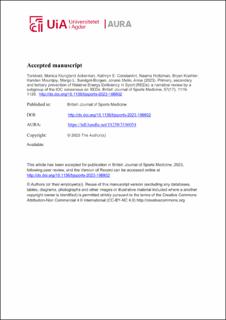| dc.contributor.author | Torstveit, Monica Klungland | |
| dc.contributor.author | Ackerman, Kathryn E. | |
| dc.contributor.author | Constantini, Naama | |
| dc.contributor.author | Holtzman, Bryan | |
| dc.contributor.author | Koehler, Karsten | |
| dc.contributor.author | Mountjoy, Margo L. | |
| dc.contributor.author | Sundgot-Borgen, Jorunn | |
| dc.contributor.author | Melin, Anna | |
| dc.date.accessioned | 2023-12-05T12:48:48Z | |
| dc.date.available | 2023-12-05T12:48:48Z | |
| dc.date.created | 2023-10-25T14:44:19Z | |
| dc.date.issued | 2023 | |
| dc.identifier.citation | Torstveit, Monica Klungland Ackerman, Kathryn E. Constantini, Naama Holtzman, Bryan Koehler, Karsten Mountjoy, Margo L. Sundgot-Borgen, Jorunn Melin, Anna (2023). Primary, secondary and tertiary prevention of Relative Energy Deficiency in Sport (REDs): a narrative review by a subgroup of the IOC consensus on REDs. British Journal of Sports Medicine, 57(17), 1119-1126. | en_US |
| dc.identifier.issn | 1473-0480 | |
| dc.identifier.uri | https://hdl.handle.net/11250/3106054 | |
| dc.description | Author's accepted manuscript | en_US |
| dc.description.abstract | Relative Energy Deficiency in Sport (REDs) is common among female and male athletes representing various sports at different performance levels, and the underlying cause is problematic low energy availability (LEA). It is essential to prevent problematic LEA to decrease the risk of serious health and performance consequences. This narrative review addresses REDs primary, secondary and tertiary prevention strategies and recommends best practice prevention guidelines targeting the athlete health and performance team, athlete entourage (eg, coaches, parents, managers) and sport organisations. Primary prevention of REDs seeks to minimise exposure to and reduce behaviours associated with problematic LEA. Some of the important strategies are educational initiatives and de-emphasising body weight and leanness, particularly in young and subelite athletes. Secondary prevention encourages the early identification and management of REDs signs or symptoms to facilitate early treatment to prevent development of more serious REDs outcomes. Recommended strategies for identifying athletes at risk are self-reported screening instruments, individual health interviews and/or objective assessment of REDs markers. Tertiary prevention (clinical treatment) seeks to limit short-term and long-term severe health consequences of REDs. The cornerstone of tertiary prevention is identifying the source of and treating problematic LEA. Best practice guidelines to prevent REDs and related consequences include a multipronged approach targeting the athlete health and performance team, the athlete entourage and sport organisations, who all need to ensure a supportive and safe sporting environment, have sufficient REDs knowledge and remain observant for the early signs and symptoms of REDs. | en_US |
| dc.language.iso | eng | en_US |
| dc.publisher | BMJ Publishing Group | en_US |
| dc.rights | Navngivelse-Ikkekommersiell 4.0 Internasjonal | * |
| dc.rights.uri | http://creativecommons.org/licenses/by-nc/4.0/deed.no | * |
| dc.title | Primary, secondary and tertiary prevention of Relative Energy Deficiency in Sport (REDs): a narrative review by a subgroup of the IOC consensus on REDs | en_US |
| dc.type | Peer reviewed | en_US |
| dc.type | Journal article | en_US |
| dc.description.version | acceptedVersion | en_US |
| dc.rights.holder | © 2023 The Author(s) | en_US |
| dc.subject.nsi | VDP::Medisinske Fag: 700::Idrettsmedisinske fag: 850 | en_US |
| dc.source.pagenumber | 1119-1126 | en_US |
| dc.source.volume | 57 | en_US |
| dc.source.journal | British Journal of Sports Medicine | en_US |
| dc.source.issue | 17 | en_US |
| dc.identifier.doi | http://dx.doi.org/10.1136/bjsports-2023-106932 | |
| dc.identifier.cristin | 2188457 | |
| cristin.qualitycode | 2 | |

